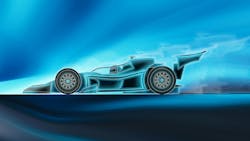Smarter Energy Management Strategies: Lessons from Formula E’s AI and Battery Tech
When you hear something like the ultimate energy management strategy, what pops into your mind? I’ll bet it’s not Formula E racing! For anyone not familiar with the term Formula E racing, it’s like Formula 1 auto-racing, but using electric vehicles (EVs). It started back in 2014 and now we have just finished season 11. Let me explain why I said Formula E racing is important when it comes to energy management. Would it be surprising to learn that the race cars started the race with nearly 50% of the on-board energy they needed to finish the race?
That’s why I said Formula E racing makes me think of energy management strategies. It’s an amazing venue for showing how leading-edge technology gets these e-race cars across the finish line. Using advanced technologies to develop strategies and make e-racers run more efficiently seems like a logical progression. Plus, what happens on the racetrack finds its way to the streets if it’s successful. We can’t forget that the racetrack is the toughest test site available, and what is successful moves into many areas, even the power grid!
This past season saw the Gen3 Evo e-racer set many records and prove some amazing concepts. So how does an e-racer finish a race when it starts out with less than 50% of the power needed to run the race? And why is it important? The season ended on a positive note. The innovative technologies introduced this season worked. The lessons learned will improve global EV sales and that’s good for consumers and the power grid. Let’s look specifically at the battery enhancements. They interact with other critical elements in the e-racer’s power system including the energy management systems, which can be applied to the performance of the power grid.
Using Resource Wisely
The battery advancements found in the Gen3 Evo really pushed the technological boundaries by improving energy density, better overall durability, and increasing resiliency. Most importantly, it was designed to operate with the new 600kW (kilowatt) all-wheel drive (AWD) regeneration braking package. This package reclaims nearly 50% of the energy needed for the Gen3 Evo to finish the race. In addition, this season there is a groundbreaking ultra-fast charging system to contend with.
This high-tech innovation provides a 10% energy boost and there’s a new mid-race 30 second pitstop required for it to be used. Holding all of this together is the state-of-the-art software that’s integrated with AI (artificial intelligence). That’s where the energy management strategies are fine-tuned. These AI algorithms are taking advantage of real-time telemetry data linked with real-world conditions surrounding the e-race car. They’re also linked to related databases such as weather, track conditions, etc.
By analyzing all of this big-data, the AI-driven technology predicts power demand, identifies inefficiencies, and optimizes energy use throughout the race. Hmm, that sounds a lot like what the power grid’s energy management systems are doing. Of course some would say a key element in the grid’s energy strategy is coordinating renewable energy, but how different is that from the e-racer’s regenerative braking system?
Working Smarter
Once an AI model is developed, it’s possible to tweak or revise it. The amount of work involved depends on the size of the revision and how extensive that revision is. Still, if there are enough commonalities it should speed up the process and energy management strategies have one thing in common. It’s all about keeping energy available 100% of the time, which is challenging for our power delivery system.
As we have discussed previously, energy demand is growing and expected to increase by about 50% by 2050. We’ve also talked about the aging infrastructure and the ASCE 2025 U.S. infrastructure report card. ASCE dropped the energy sector to a grade of D+, which represents an infrastructure that’s below standard. It’s a condition of serious concern with a strong risk of failure according to ASCE. And that was before the recent announcements from the federal government that they were terminating funding and permits for approved renewable energy and transmission projects.
Moving the energy sector into ASCE’s C category is going to require major infrastructure investments across the board. It’s also going to take a great deal of time and effort. In the interim, however, grid enhancing technologies are going to have to pick up the slack. AI-driven energy management strategies will help pick up the slack. This is a complicated issue that’s not going away, and our traditional approaches need help!
About the Author
Gene Wolf
Technical Editor
Gene Wolf has been designing and building substations and other high technology facilities for over 32 years. He received his BSEE from Wichita State University. He received his MSEE from New Mexico State University. He is a registered professional engineer in the states of California and New Mexico. He started his career as a substation engineer for Kansas Gas and Electric, retired as the Principal Engineer of Stations for Public Service Company of New Mexico recently, and founded Lone Wolf Engineering, LLC an engineering consulting company.
Gene is widely recognized as a technical leader in the electric power industry. Gene is a fellow of the IEEE. He is the former Chairman of the IEEE PES T&D Committee. He has held the position of the Chairman of the HVDC & FACTS Subcommittee and membership in many T&D working groups. Gene is also active in renewable energy. He sponsored the formation of the “Integration of Renewable Energy into the Transmission & Distribution Grids” subcommittee and the “Intelligent Grid Transmission and Distribution” subcommittee within the Transmission and Distribution committee.
